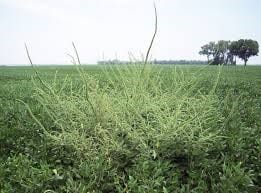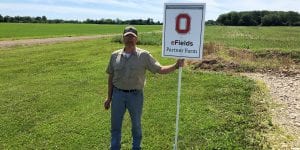by: Mark Loux
 If you don’t already have to deal with waterhemp or Palmer amaranth, you don’t want it. Ask anyone who does. Neither one of these weeds is easy to manage, and both can cause substantial increases in the cost of herbicide programs, which have to be constantly changed to account for the multiple resistance that will develop over time (not “can”, “will”). The trend across the country is for them to develop resistance to any new herbicide sites of action that are used in POST treatments. Preventing new infestations of these weeds should be of high priority for Ohio growers. When not adequately controlled, Palmer amaranth can take over a field faster than any other annual weed we deal with, and waterhemp is a close second. Taking the time to remove any Palmer and waterhemp plants from fields in late-season before they produce seed will go a long way toward maintaining the profitability of Ohio farm operations. There is information on Palmer amaranth and waterhemp identification on most university websites, including ours – u.osu.edu/osuweeds/ (go to “weeds” and then “Palmer amaranth”). An excellent brief video on identification can be found there, along with a fact sheet. The dead giveaway for Palmer amaranth as we move into late summer is the long seedhead, and those on female seed-bearing plants are extremely rough to the touch.
If you don’t already have to deal with waterhemp or Palmer amaranth, you don’t want it. Ask anyone who does. Neither one of these weeds is easy to manage, and both can cause substantial increases in the cost of herbicide programs, which have to be constantly changed to account for the multiple resistance that will develop over time (not “can”, “will”). The trend across the country is for them to develop resistance to any new herbicide sites of action that are used in POST treatments. Preventing new infestations of these weeds should be of high priority for Ohio growers. When not adequately controlled, Palmer amaranth can take over a field faster than any other annual weed we deal with, and waterhemp is a close second. Taking the time to remove any Palmer and waterhemp plants from fields in late-season before they produce seed will go a long way toward maintaining the profitability of Ohio farm operations. There is information on Palmer amaranth and waterhemp identification on most university websites, including ours – u.osu.edu/osuweeds/ (go to “weeds” and then “Palmer amaranth”). An excellent brief video on identification can be found there, along with a fact sheet. The dead giveaway for Palmer amaranth as we move into late summer is the long seedhead, and those on female seed-bearing plants are extremely rough to the touch.
If you need help with identification, call John at 740-397-0401.
Continue reading No Pigweed Left Behind – Late-Season Scouting for Palmer Amaranth and Waterhemp









